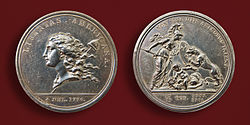France (for the United States) | |
| Value | Non-circulating |
|---|---|
| Diameter | 47-48 mm (1.85-1.89 in) |
| Edge | Plain |
| Composition | Gold, silver (.925 fine), copper/bronze |
| Gold | 1.85 troy oz |
| Silver | 1.47 troy oz |
| Years of minting | 1783 (original) with modern strikes and reproductions |
| Mintage | Limited |
| Obverse | |
 | |
| Design | Draped bust of Liberty facing left with flowing hair |
| Designer | Augustin Dupré, Benjamin Franklin |
| Reverse | |
| Design | Infant Hercules (young America) strangling two serpents (representing British Generals Burgoyne and Cornwallis); Minerva defends with shield of fleur-de-lis against a lioness (Britian) |
| Designer | Esprit-Antoine Gibelin |
The Libertas Americana was a medal made to commemorate the American Revolution. It was designed in part by Benjamin Franklin. [1] [2]
Contents
A Libertas Americana was showcased on season 15 of the American reality television series Pawn Stars . It was sold for $150,000. [3]